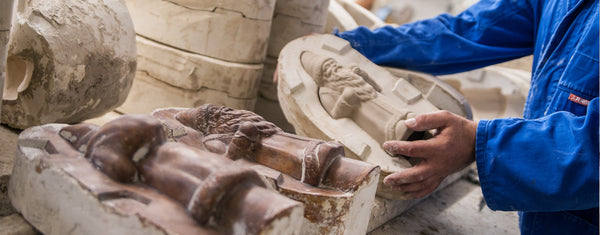
The Schaller Family Business
Carl Schaller ~ Ino Schaller ~ Dieter Schaller ~ Thomas Schaller from 1894 to the present.
Carl Schaller started a company in his home to produce paper holiday articles, including paper mache, flocked, and pressed cardboard items, in 1894, in Neustadt-by-Coberg, in Bavaria, in west central Germany. His pieces, especially the paper mache candy containers that open from the bottom or middle, were exported to the United States by Woolworth's, which had a warehouse in nearby Sonneberg until 1939.
Ino Schaller inherited his father Carl's business, but by the late 1940s, he moved into pressed cardboard figures, and by the 1960s was producing pressed plastic forms as well.
Dieter Schaller, Ino's son, also made cardboard toys and figures, such as rabbits, ducks and Santas. Both Ino and Dieter produced plastic plush-covered figures through the '70s and '80s, and the family continues to produce them today.
Thomas Schaller, Dieter's teenage son, found his great grandfather's candy container molds in the family's attic in the mid-1980s. Fascinated, he sought the help of his father Dieter to revive the craft of mold casting and pouring paper mache.
Today, there are many candy container "reproductions," but nothing matches the integrity, quality and artistry of one made in the original mold, by the same family, in the same house where the original family business began more than 100 years ago.
The pictures below are from a recent visit to the Schaller family home and workshop in Neustadt-by-Coburg.

The process of making Ino Schaller paper mache and composition figures takes seven days. On the first day, the craftsperson combines liquefied paper, clay, glue, and a few secret mineral ingredients. On the second day, the worker blends the mixture to a smooth consistency and pours it into a two-part plaster mold. In a short while, the plaster draws out some of the water content, leaving a thin paper mache shell.

The crafter pours out the excess liquid, and the shell dries through the third day. On day four, the artisan dips the paper mache form in liquid plaster, creating a thin, smooth white skin for the hand painted details and trim. The plaster skin makes this a "composition" figure. On the sixth, seventh and eighth days, the artist applies layers of paint, fine details, and glaze, with drying time between each coat. Finally, the artists apply the finishing touches such as chenille, cellulose shavings, ground glass and mica.

Roger Lund, owner of The Christmas Haus, selecting candy containers in the Ino Schaller showroom in Neustadt-by-Coburg.

Roger Lund, owner of The Christmas Haus, and Thomas Schaller, 4th generation head of the family company.
